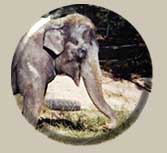Information processing and assessment - students use information gathered to create their own Elephant Biographies about the elephants. Each student writes several pages about one of the elephants. Information in the pages can include the elephants age, when it was captured, injuries sustained, favorite food, special personality trait, special events in the elephants life (one elephant has traveled around the world in circuses), average age of elephants, how the Sanctuary recreates the elephants natural habitat and how the natural habitat is important to an elephants health. (e.g. Elephants unable to walk 40 miles a day an varied terrain often suffer from foot rot, a deadly disease.) Students can include in their pages photos from the web site, their own writing and thoughts about the elephants, facts gained through the elephant study, and their own artwork.
Students can continue to do their own research and information gathering as they write their book pages. As students work on the computer building their pages, they can switch back and forth from the web site, too.
An exciting an unique learning tool that continues in this phase is the frequently updated diaries the Elephant Sanctuary compiles. Students learn of the progress of a newly arrived endangered elephant through the diary the Sanctuary publishes on line. The diary includes photos and extensive educational information about how elephants live and how they learn to adapt as they are reintroduced into their natural habitat. (The Elephant Sanctuary in Hohenwald, Tennessee, has recreated, to a great extent, the Elephants natural habitat. They are able to roam free and live as a herd, and so for the first time since they were captured in Asia, are able to walk the 40 miles a day important to their health.) Social Studies standards 1, 3, 7, 8 and 10 are incorporated in this phase.
Final assessment phase- the Elephant Biographies book, authored by the students, is published, and the students give a multimedia slide show presentation (built into ClarisWorks) to their peers and special visitors. In another authentic assessment opportunity students share their expertise with parents, through an Internet Project Journal with 4 weekly activities parents and students work on at home.
In this first year, students also initiated and planned a school wide fair - Winkie Day! - a day of letter signing and fund raisers for the whole school. Their effort was to help Winkie, an elephant in a Wisconsin Zoo that the Elephant Sanctuary hoped to take in. Their additional interest in helping Winkie, led students to learn about how the Sanctuary endows Elephants, raises money for them and cares for them. Social Studies standards 11, 12 and 17 were additional standards incorporated in this phase.
It should be noted that the first and second graders that created the booklets this year are language learning disabled, yet all were inspired by the task, created excellent elephant biographies, and excelled because of the multisensory approach which was used to teach this unit. The multisensory components included listening, reading, writing, drawing, viewing videos, and the hands-on work that the computer use requires.
Any school or classroom with Internet access and ClarisWorks or Microsoft Word could replicate the fundamental components of this unit. Teaching and learning any integrated technology unit is enhanced if a computer lab is available and student access to our lab facilitated this unit. Students used imacs with 32 mb of memory to create their pages. The computers were more than adequate for allowing the Internet/ClarisWorks multitasking. To replicate this project in other classrooms and schools requires Internet access so teachers and students can visit the web site and use email to contact the director, and access to software such as ClarisWorks, that allows students to combine text and graphics to create a book. We were able to borrow a digital camera and In-Focus projection device which en abled us to add student drawings to the booklet (a scanner would have worked, too), student photos, and to present the book in a multimedia presentation. A school without a projection device could have students present their book in a more traditional format, simply showing the pages of the book.
|
